The riddle of the SPB or why the dive bomber did not go into the series
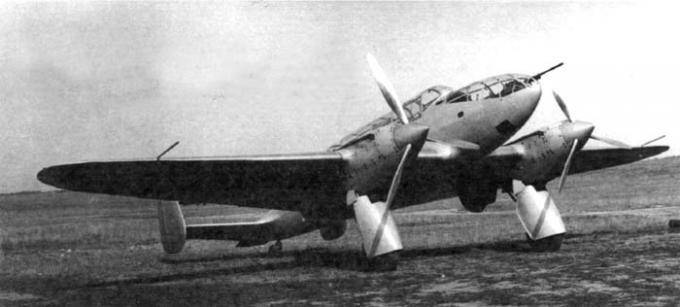
For the first time, the question of creating a dive bomber in the USSR capable of bombarding angles up to 60 ° was considered by the Air Force in '1934. It was supposed to issue a task for a machine with an M-34FRN motor to VF Rentel, but the plant at which he was working at that time refused the order. The attempt to involve in the work of the team of the VVIA named after N. Ye. Zhukovsky failed.
The ship reconnaissance officer G. M. Beriev KOR-1936 is created in 1. Tactical and technical requirements provided for his use as a dive-gunner. The plan of an experienced aircraft building on 1936 — 1937 years was to build a single-engine PB dive bomber with an M-85 engine at plant No. 1 with a maximum speed of 400 — 450 km / h with a normal range of 800 km. But due to the specialization of this plant for intelligence officers in 1937, the entire reserve of the M-85 PB aircraft was transferred to plant No. 135. How it all ended while it was not possible to detect.
In the same year, N. N. Polikarpov, on his own initiative, began the development of a twin-engine high-speed high-altitude three-seater SVB bomber with M-100 engines. Since it did not provide for the use of pressurized cabs and turbochargers, then we could talk about creating a conventional front-line bomber in accordance with the existing concept. Soon, Polikarpov was allocated a production base at factory number 84 in Khimki. A plant recently transferred to aviation The industry from the Civil Air Fleet was distinguished by outdated equipment and did not have a sufficient number of qualified specialists.
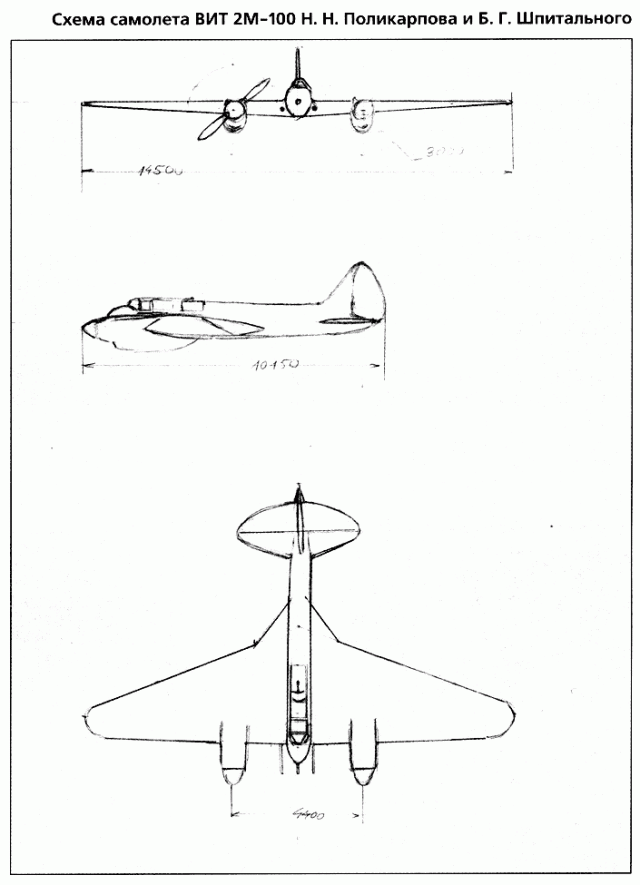
By mid-February 1937, the drawings of the SVB aircraft were completely ready. But he did not get into production, and on its basis a two-engine twin-engine air fighter was developed tanks VIT-1.
At the same time, Polikarpov proposed a twin-engine, multi-seat cannon fighter (MPI).
It should be noted that, having invaded the "Tupolev" theme, Nikolay Nikolayevich not only did not find support in the SUAI, but also ran into direct opposition from the chief engineer of the aviation industry.
The Air Force did not accept the idea of an anti-tank aircraft and recommended that Polikarpov concentrate his efforts on a multi-seat cannon fighter for the speedy implementation of the project. The customer hoped that the MPI would demonstrate the declared flight data and become a kind of accelerator in the creation of promising machines that fit into the concept of the Air Force leadership.
31 January 1937-th worked mock-up commission on the MPI aircraft. On July 25, the government approved the plan for the Air Force in 1934. It was supposed to issue a task for a machine with an M-34FRN motor to VF Rentel, but the plant at which he was working at that time refused the order. The attempt to involve in the work of the team of the VVIA named after N. Ye. Zhukovsky failed. experienced aircraft for the current year, which provided for the construction of two prototypes of a fighter with two M-100 engines and a maximum speed of 500 — 550 km / h.
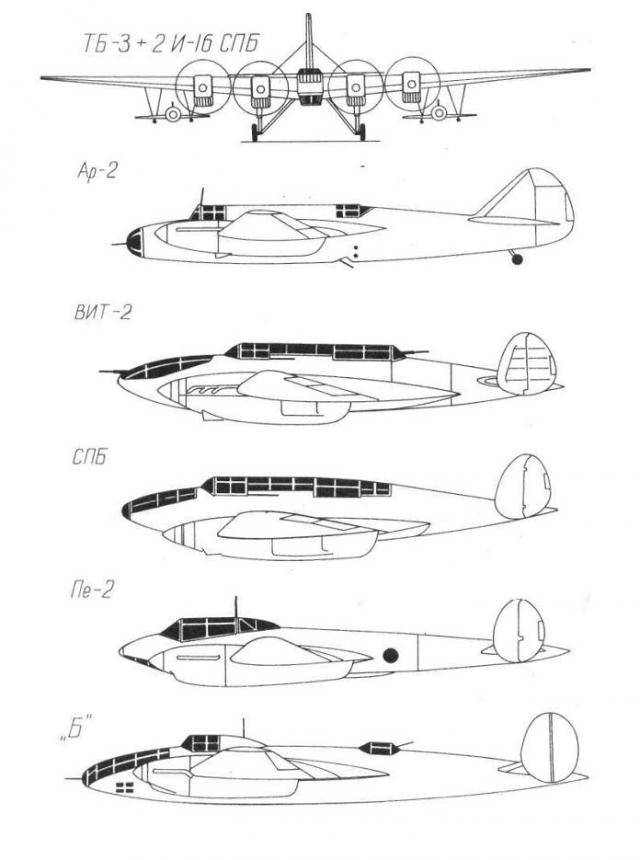
October 13 Polikarpov presented a draft design of a WIT-2 aircraft with M-103 engines (there were no M-105 engines yet). All worked seven versions of this machine, including a dive bomber. Officially, the VIT-2 in the draft design was presented in three versions: a near-speed bomber (BSB), VIT and DIM. The first option aroused the greatest interest among the military.
The next day, finished assembling the first flight copy of WIT-1 (MPI). His factory tests, which lasted until February of the 1938, were not fully completed due to the mismatch of the flight characteristics given. And still, basically the plane was a success, but due to the lack of support from the GUAP, the car was not brought in and was not transferred to state tests. Since the VIT-1 had a strong weapon for that time - two wing cannon ShFK-37 caliber 37 mm, the Air Force took the car to the joint ground test. In this case, the guns were highly appreciated, and the pilots noted the good behavior of the aircraft during a dive.
On the second copy of the machine (HIT-2) Polikarpov installed two-fin plumage and introduced the third crew member, the navigator. Now, it was possible not to worry about the defense of the rear hemisphere, and to improve the flight data, the designer chose the more powerful M-105 engines. But the engines did not appear in time, and 10 in May 1938-th from the assembly shop rolled out an experienced VIT-2 with old M-103 engines.
The next day, V.P. Chkalov made the first flight on it. All subsequent flights at the stage of factory tests, which ended on July 11, were performed by test pilot of plant No. 84 B. N. Kudrin. With a take-off weight of 6166 kg, HIT-2 at a height of 4500 m developed a maximum speed of 498 km / h, and with a weight of 5310 kg - 508 km / h. Not bad for a start.
After the end of the factory tests, the M-103 motors were replaced by the M-105. Polikarpov was the first to take upon himself the brunt of mastering engines that were completely unfinished by that time. It all started with a scandal. The plant sent completely unserviceable samples, which later played a fatal role in the fate of the modification of HIT-2 - SBP aircraft.
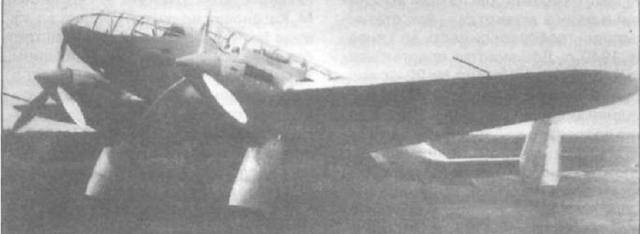
HIT-2 without weapons at the test stage
The second stage of the factory testing of HIT-2 took place from August 2 to 10 September 1938. Considerable time was spent on testing and fine-tuning not so much the aircraft as the engines. Despite the fact that their power increased, the maximum speed reached only 513 km / h. By that time, this was a good result, but the NKAP still did not provide support to Polikarpov in the work on WIT-2.
As the leading engineer of the Scientific Research Institute of the Air Force on the plane HIT-2, P. Nersisyan, wrote, Osipenko was banned from plant manager No. 84 from showing the aircraft to the Air Force leadership. And only after Nersisyan's letter to KE Voroshilov was shown the aircraft to Ya. V. Smushkevich. After inspecting the car, Smushkevich interrupted the factory tests and ordered to overtake him at the Chkalovskaya airfield for display to the government. After the show, HIT-2 was left at the Air Force Research Institute for joint testing. In addition to Nersisyan, the test crew included pilot P. M. Stefanovsky, jokermen P. Nikitin and P. Perevalov.
From September 13 to October 4, 1938-th performed 35 flights with a total duration of 13 hours 40 minutes. When the flight weight in 6300 kg at an altitude of 4500 m reached the speed of 483 km / h. The speed obtained at factory tests was overstated by 15 km / h. At the same time, the identified tail vibrations in different modes and the impossibility of a long flight on one motor did not allow to determine the ceiling, range, maneuverability and other characteristics. Before the transfer of the aircraft to the series, it was required to bring it up, and October XITUMN-5 was returned to the plant on October 2.
From 9 to 26 in February, 1939-th successfully passed the secondary state tests of the modified HIT-2. After installing the VISH-2E screws, changes in the canopy of the cockpit canopy of the gunner-radio operator and water radiators obtained the maximum speed at the ground of 446 km / h and at the height of 4600 m - 500 km / h.

As a result, the aircraft had indisputable speed advantages over all existing serial and experienced aircraft of its class. The military insisted on using HIT-2 as a dive bomber, which is why the name SPB (speed diving bomber) appeared. Polikarpov did not agree, believing that he created the SBP — a high-speed bomber, which could, if necessary, be used as a dive-bomber. Such caution is understandable - the SVB aircraft, on the basis of which the VIT-2 originated, was designed as a high-speed bomber, and if it was turned into a dive-bomber meeting more stringent strength standards, it would inevitably have to sacrifice flight performance. It so happened that in the documents of the Air Force the plane was originally called SPB, and in the documents of the NKAP - SBP and only later also SPB.
In a letter to the People's Commissar of the aviation industry M. Kaganovich, the head of the Red Army Air Force Loktionov noted:
“The aircraft has reserves up to 50 km / h to increase speed, which consists in: a) installing a more powerful and high-altitude motor M-105; b) radical improvement of the outer surface of the aircraft; c) the best selection of screws.
It was noted that the control of the aircraft was normal (it was unacceptably heavy). Vibrations of the tail in all modes, including the ultra-maximum speed of 650 km / h, have disappeared. It became possible to fly on one engine. Despite the high wing loading (up to 157 kg / m2), HIT-2 was available to pilots with a moderate qualification for piloting techniques, and even easier for SB-2 and DB-3 in take-off and landing properties, requiring a smaller landing pad.
March 9 The head of the Red Army Air Force A. D. Loktionov wrote M. Kaganovich to 1939:
"The Military Council of the Red Army Air Force considers it appropriate:
Make a decision on the provision of the SPB aircraft (HIT-2) for launch into serial construction.
Simultaneously with the development of drawings and the preparation of production of mass-produced airplanes, force the construction of 2-x control samples of airplanes (...) with the expectation of passing the NII VVS for state testing no later than IX. 1939 and the head series of aircraft for military trials no later than IV. 1940
Continue testing of the existing HIT-2 aircraft under the full state testing program and eliminate the defects identified during serial construction. ”
28 in March K. Ye. Voroshilov and M. Kaganovich prepared and sent to B. M. Molotov and I. V. Stalin a memorandum on the organization of serial production of SBPs at plant No. 124. The next day, Molotov signed the corresponding decree, but soon it had to be canceled.
April 27 X. NUMX M. Kaganovich after a trip together with Polikarpov and the Deputy Chief of the Air Force Institute I. Petrov at the 1939 plant wrote to Stalin and Molotov:
“Comrade. Polikarpov categorically objected to the production of the SBP aircraft at this plant, since the drawings of the aircraft that had passed state tests are currently being completely reworked constructively and technologically, which will require the manufacture of two prototype machines for static and flight tests. how these cars will be completely different from cars that have passed state tests.
Me in coordination with the head of the Department of Internal Affairs, comrade. Loktionov appointed a commission to determine the technical condition and the possibility of implementation in a series of SBP.
In the resolution KO at SNK of the USSR from 5 in May 1939, “On the introduction of modified aircraft into mass production and the creation of new aircraft in 1939 — 1940. of the type of bombers, attack aircraft and reconnaissance aircraft, prepared under the leadership of Smushkevich, it was noted that the organization of the production of SPB (HIT-2) at plant number 124 is impossible
"Because of the unpreparedness of the technological base of the plant to the new aircraft"
and the establishment of serial production of the TB-7 bomber.
In the same year, a meeting of representatives of the Air Force Research Institute and the industry was held on the establishment of the tactical and technical characteristics of an SPB aircraft launched into production at plant No. 22. The meeting participants, after hearing the report of Polikarpov, approved the changes made to the aircraft by the SBP, in comparison with the WIT-2с drawings (the letter “c” means serial - approx. Author), as contributing to obtaining greater speed, simplifying assembly technology and a quick transition to another motor.
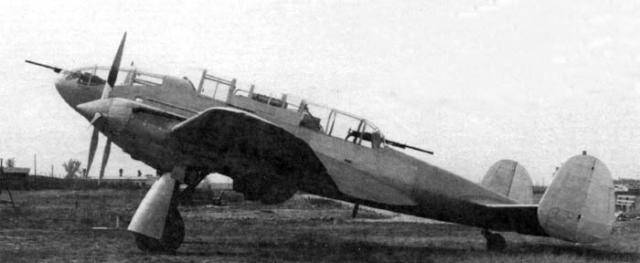
The response to this decision followed immediately. Two days later, resolutions of the CP of CPC No. 221 and 249 on the organization of mass production of SPB at plant No. 22 appeared. The first two aircraft for flight tests and one in aggregates - for statistical tests, it was required to hand over 1 before 1940 in January. The document prescribed that plant No. 22 should be released from the introduction of the MMN aircraft in the series (the last modification of the SB).
This decision created the preconditions for the aggravation of Polikarpov's relations with the chief designer of the 22 plant, A. A. Arkhangelsky, and the director, Okulov, which later affected the construction of the SPB.
The Resolution stated:
"Work on the introduction of SPB aircraft at the plant number 22 (...) Comrade. Polikarpov considered priority ... "
By the resolution of KO SNK, Polikarpov was entrusted with the task of designing and building, on the basis of SBP-1, two PB-1 airplanes (diving bomber) with two M-120 or M-71 engines, presenting the first 1 prototype in July of 1940.
October 25 1939-th draft design of a SBP dive bomber with M-71 and M-81 engines was sent to M. Kaganovich. In a memorandum, Polikarpov noted: “SBP is a promising aircraft and has large speed and strength reserves.” It was proposed to provide a quick transition to other engines without a major alteration of the aircraft design. In order to further develop the SBP and increase its flight and combat data, install M-106, M-81 or M-71 engines (including with turbo-compressors) on it.
To reduce the speed of the dive to 500 km / h and improve maneuverability when taxiing, it was planned to install reversing screws. In the future, SBP could be built with M-82A and M-82FN motors, which allowed to reach speeds of 600 — 620 km / h. Air Force Institute gave a positive conclusion on the draft design of the SBP (PB-1) with M-71 and M-81. But the leading engineer for HIT-2 Nersisyan believed that Polikarpov should not be given a task on PB-1 in order not to be distracted from the completion of SPN 2М-105, the layout of which was approved by October 26.
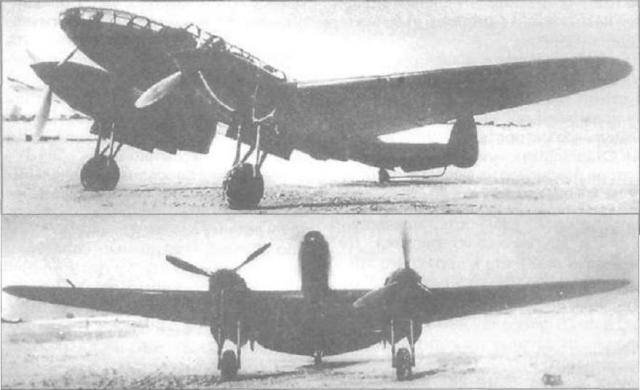
It seemed that there were no obstacles for the work of the Polikarpov team. In reality, it was different. In November, 1939-th, sending the chief designer to Germany, M. Kaganovich ordered to create a design bureau at the plant No. 1 for maneuverable fighters headed by A. I. Mikoyan. How it ended is well known. At the same time, an experimental design department (EAD) was created at the same plant, where designers were transferred from the Polikarp Design Bureau to 80, including those who worked on the “D” machine (factory designation SBP).
In fact, the defeat of the Polikarpov Design Bureau began. It is surprising that one of the most talented aviation designers constantly moved from the factory to the factory and by the beginning of the 1940-s did not receive its production base. This, naturally, affected his moral state at such a crucial moment as the completion of experimental work and the conduct of SPB tests.
Shortly before the New Year, Polikarpov sent a letter to the NKAP with a message about the financial difficulties of the OKB due to the incompletely paid work of 1939 and the lack of programs and credits for 1940.
There he also recalled that the response to the draft draft PB-1 from either the NCAP or the GUAS (Main Department of Air Supply) has not yet been received. But the last day of 1939 was a little pleased: the plant built the first copy of the SPB aircraft No. 2,5 / 1 for the month of 0.
At the same time, Polikarpov’s competitors were also active. 14 of April S. A. Kocherigin sent to the customer a preliminary design of the original single-engine single-seat high-speed dive bomber of the OPB with the M-90 engine, and 20 in May presented its model.
From 11 April to 10 in May, state tests of the 100 aircraft (the predecessor of the famous Pe-2 — Ed.) In the variant of the high-altitude fighter were held. In the conclusion of the report of the Institute of Air Force noted:
“In order to use the high aerodynamics of the 100 aircraft and create on its base a mass diving bomber without a pressurized cabin, with a maximum speed at an altitude of 5000 and at least 550 km / h with a bomb load inside 600 kg and outside 1000 kg to require the design bureau to develop an 100 aircraft "In the form of a dive bomber. Present a model for 1 June 1940. According to the approved model, build a military series. ”
28 May approved a report on state tests of the aircraft SB-RK with the recommendation after fine-tuning to launch it into a series in the version of a dive bomber.
1 June, Resolution KO No. 239 on the construction of three prototypes of A.N. Tupolev's 156 airplane with AM-103А or M-35 engines at 120 No. 30, and its draft design was approved on XNUMX August.

15 June approved the layout of the aircraft "100" in the version of the dive bomber PB-100. After 8 days, the KO Decision No. SNN 275 on the introduction of the 100 aircraft into serial production in the version of a diving bomber based on a high-altitude fighter was issued.
On August 7 KO No. 342 was issued on the construction of two prototypes of the OP-B M-90 aircraft.
On September 21, the NKAP commission reviewed the draft design for the modernization of the A. S. Yakovlev BB-22 aircraft into the short-range dive bomber BPB-22, developed at the plant No. 81 by L. P. Kurbaloy. Despite the fact that the Air Force did not approve the project, BPB-22 began to build. A month later, he took to the air in the version of the short-range bomber BB-22bis.
October 15 Air Force reviewed the cockpit mock-up of a diving bomber B-2 designed by A. A. Arkhangelsky.
On November 18, a commission composed of S. N. Shishkin, I. F. Petrov and A. V. Chesalov, after conducting a comparative assessment of PB-100, SB-RK and B-2, and BB-22, gave recommendations on the choice of aircraft for mass series. Really existing SPB aircraft for unknown reasons was excluded from the competition. Of these machines were built only SB-RK and B-2.
The commission’s conclusions stated that, according to tactical flight and combat data, the best plane among those examined was PB-100, as it had the greatest bomb load, the greatest range, the best fire protection and speed, with the possibility of further increasing it by modifying the aircraft, as well as highest strength.
The main disadvantages of PB-100 were its relative high cost and the use of duralumin. Therefore, it is necessary, when introducing the PB-100 aircraft into the mass series, to be saved in the production of the BB-22, as a cheap aircraft from non-deficient materials, suitable for training and training crews, as well as for use on certain sectors of the front. As for the SB-RK, it was inferior to the PB-100 and did not have the prospect of a significant improvement in flight data. The decision on the aircraft "B" was postponed until the tests.
December 2 built the lead production aircraft PB-100 (Pe-2). December 14 approved the conclusions on draft designs of two-engine escort fighters Polikarpov - TIS and Mikoyan and Gurevich DIS-200 with engines AM-37. Both aircraft were designed with the possibility of using them as dive bombers.
The TIS, being a direct development of the SPB, had the option of dropping four FAB-100 bombs from the internal suspension using a special exhaust cassette. Up to two bombs with a caliber of no more than 500 kg could be suspended on the outer suspension.
DIS-200 to some extent was also the development of SPB, since Gurevich participated in its development, taking into account the accumulated experience. For the DIS-200, only the option of the external suspension of a single bomb FAB-1000 was provided.
During 1940, the customer was presented with a number of still unimplemented projects of diving bomber.
3 January 1940-th in conclusion on the draft design of PB-1 (SPB) with M-71 engines, it was noted that it meets the requirements for a dive bomber. In particular, a twelvefold safety margin is required to ensure dive bombing at an angle of 90 °. Bombing was to be carried out with internal hangers. Note that the later adopted Pe-2, the German U-88 and Pre-217, allowed dive-bombing only from external hangers. In addition, bombing with angles greater than 70 ° had no practical meaning and, therefore, the strength declared by Polikarpov turned out to be quite sufficient.
By January 10 built a second prototype of the SPB No. 2 / 0. After 8 days, pilot B.N. Kudrin and flight engineer I.S. Popov made the first flight in car no. 1 / 0. March 26 began flight tests SPB number 2 / 0. April 17 made the first flight of the first production aircraft number 1 / 1.
April 26 began flight tests of the first production aircraft number 2 / 1, and the next day he, piloted by test pilot P. G. Golovin, crashed. The mission was to determine the controllability and stability of the aircraft at an altitude of 2000 — 3000 m in the zone of the Central Aerodrome. The flight was watched by Polikarpov and his deputy Zhemchuzhin, as well as the head of the technical bureau of the Usachenko plant.
Half an hour after takeoff, the plane broke into a corkscrew and fell on the airfield of the Research Institute of the Civil Air Fleet, burying the crew.
After inspecting the remains of the aircraft and the crew, the commission chaired by A. V. Lyapidevsky, the chief of the 8 division of TsAGI, concluded that at the time of the accident, the ailerons and tail unit were in good condition, and the landing gear was in a clean position. The absence of metal chips in the oil filters seemed to indicate the normal operation of the motors. The commission noted that the cause of the catastrophe was the transition of the aircraft into a flat spin. The cause of the breakdown could be the hit of an aircraft with insufficient longitudinal stability in the clouds. The breakdown could also occur due to rough piloting.
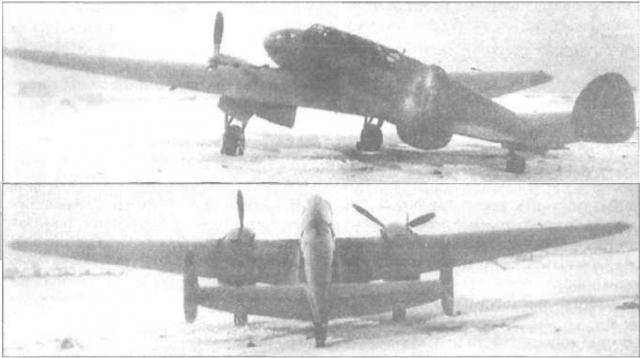
All these versions have practically not been proved by objective facts and are largely subjective. Let's pay attention to some circumstances missed by the commission. 26 April Golovin overtook the SPB No. 2 / 1 from the factory to the Central Airfield. When asked how the car behaves and what its impressions are, Golovin replied that the car was fine, only the right engine has a temperature of water and oil on 15 ° more than the left one. And Shishmarev, in his testimony, noted that M-105 motors had seized up earlier.
We have already mentioned the absence of metal chips in the oil filters, on the basis of which it was concluded that the engines were operating normally. But from the text of the act it follows that only the left engine oil filter was investigated, as the right one was burned. Hence, the conclusion about the correct operation of both motors was not confirmed. And the most interesting, in the emergency act is a photo of the remains of the destroyed right motor, on which the whole blade of the screw is very clearly visible! This could happen if even before the crash of the aircraft the right engine was jammed. Why the commission did not pay attention to this circumstance is not clear.
Most likely a catastrophe occurred due to a motor failure followed by a loss of spatial orientation by the pilot. Of course, a certain role was played by the insufficient experience of Golovin in flights to St. Petersburg and the small reserve of the longitudinal stability of the aircraft on critical conditions.
As a result, the commission recommended:
“1) Factory flight tests of SPN 2 / 0, 1 / 1 and 3 / 1 airplanes to continue, avoiding flights in the clouds and behind the clouds.
2) Approve the decision of the plant manager No. 22 Comrade. Okulov on the prohibition of test flights of the machine № 1 / 0 due to the identified tendency on the machine to dive at high speeds until significant deviations are eliminated in the leveling.
3) Oblige the chief designer Polikarpov to immediately blow the SPB plane in kind in the wind tunnel for longitudinal stability, get the TsAGI's opinion and make all the necessary design changes.
4) Oblige Chief Designer Polikarpov to calculate the SPB plane with a tailspin and get a TsAGI opinion. ”
During the tests of the first two St. Petersburg prototype aircraft No. 1 / 0 and 2 / 0 and the serial aircraft No. 1 / 1, the engines continuously failed. The oil was thrown out of the prompters, its pressure dropped sharply, there were instances of engine spells. Recall that Polikarpov first mastered the still “raw” at that time M-105. There were forced landings and breakdowns associated with poor quality manufacturing aircraft at the plant number 22.
At the same time, the commission did not give any recommendations to the engine builders and CIAM, as well as from plant number 22.
In early May, 1940-th Smushkevich informed Stalin that the question of choosing an 100 or SPB aircraft would be decided in the coming days.
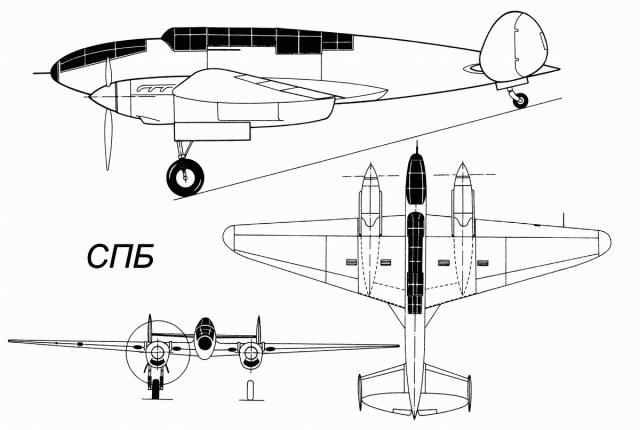
On May 15, the head of the GUAS KA Alekseev, in a letter to the People's Commissar of Defense Tymoshenko, noted that
“Go to the SB-RK, but do not reduce the program for the SPB ...”
After 10 days, Alekseev abruptly changed his attitude towards Polikarpov’s car and, in a letter to Tymoshenko, suggested launching PB-100 into production, and discontinuing the release of the SPB. I have railed for PB-100 and Smushkevich, reporting in his letter to the people's commissar Shakhurin:
“1. "Weave" to introduce at the plant number 22 only in the version of a diving bomber, it is unlikely that you can squeeze out of the Security Council.
2. SPB remove, stop work. It can be seen, nothing will come of it (like a dive bomber). Instead, "weave."
From the correspondence suggests the conclusion that initiated the "funeral" of the St. Petersburg Alekseev, who was the first to come to the Defense Commissar. Smushkevich after that raised the question at the "home" level.
June 2 due to a drop in oil pressure in the right-hand engine, an accident of an SPB aircraft no. 3 / 1 occurred. Turning off the engine, M. A. Lipkin decided to land at a factory airfield of a very limited size.
Managing the landing plates incorrectly, he did not reach the runway and touched the propeller of the SB standing on the ground with a stabilizer. When falling, the right landing gear broke up, after which the plane took off on the 60 m and, hooking the ground with the right plane, lay down on the “belly”. The machine required a major overhaul.

14 June, the head of the NKAP flight group, M. M. Gromov, having familiarized himself with the results of the tests, materials of the purging and interviews with Kudrin, Lipkin and Zhemchuzhin, in a letter to A. S. Yakovlev gave the following assessment to the aircraft:
"The engine unit was not brought, as a result of which there are forced landings (...)."
This assessment was not paid attention to in the course of the investigation of the flight accidents, making an not entirely justified emphasis on excessive rear (31%) alignment.
In June, 1940, after the reorganization at the plant number 1 KB Mikoyan, OKO "D" lost many of the managers, and with the advent of the new leadership in NCAP, about 135 designers left.
Surprisingly, in the face of the destruction of Polikarpov’s design bureau and a prejudiced attitude toward the car, by a decree of the Committee of Defense on June 1 it was ordered to issue the 15 SPB military series.

Emergency landing of SPB aircraft No. 3 / 12 June 1940
30 July was another disaster. Pilot M. A. Lipkin and engineer G. A. Bulychev died in St. Petersburg number 1 / 1. That day it was necessary, in particular, to test for flutter at the speed of 600 km / h on the device. According to the testimony of witnesses, the car, flying at high speed (as evidenced by the too sharp sound of the motors) at the height of 2000 — 2500 m began to crumble. The emergency commission, having worked for only two days, decided that the flexural-aileron wing flutter was the most likely cause of the catastrophe. There is nothing surprising. The commission consisted of administrators and the only professional was Professor TsAGI V.I. Polikovsky, an expert in the field of engine building.
All the blame for the incident was piled on the deputy chief designer N. A. Zhemchuzhina, who did not follow TsAGI’s instructions on setting weight compensation on the ailerons. According to TsAGI's calculations, the critical speed of the flutter could have occurred when the instrumental speed of 500 km / h was reached. But there was no confirmation of the achievement of this speed, and no one dealt with the commission at the TsAGI.
Even after the SPB No. 2 / 1 catastrophe, the emergency commission demanded to blow the plane in the TsAGI wind tunnel T-101. The next commission again put forward this demand, but made conclusions without waiting for the test results. They did not take into account the fact that no external signs of flexural-aileron flutter were found on the surviving left wing console and aileron. In conclusion, TsAGI, signed on July 23 by Grossman, confirmed that the flexural-aileron wing flutter at speeds up to 800 km / h could not take place.
From the fragments of the left wing, it can be established that the destruction of the wing was due to bending. At the same time, the loss of aileron resistance to compression and its rupture is not explained by the appearance of flutter. In so far known cases of aileron flutter, the wing did not collapse immediately, which is the only argument against this unproven version.
At the same time, the commission did not consider the possible spin-up of the propeller, which very often occurred during a dive, as well as with a rapid increase in speed due to "giving gas". For this reason, there have been many catastrophes, in particular, on the experienced "103" and serial Pe-2.
It was unclear whether the left engine nacelle was left in the air, although eyewitnesses noted a strong roar of the engines and the presence of traces of bright smoke, indicating the screw and the destruction of the VMG.
The probability of this version is very high. The conclusion is that the SPB aircraft was completely unreasonably compromised by the emergency commission.
29 July 1940-th People's Commissar Shahurin signed an order, where, apart from the distribution of punishments, it was said:
“Further factory testing of SPB aircraft will cease. Director of the plant number 22 Okulov and chief designer Polikarpov in three days give me a report on the costs incurred for the construction of prototypes and the zero series of SPB, the status of the reserve and considerations about its use. "
Began a slow funeral "diving bomb". The People's Commissariat at the same time took a wait-and-see attitude, not taking any measures to implement the proposals of the emergency commission. Ended the last prewar year. Polikarpov’s request to send inquiries into catastrophes of Golovin and Lipkina, Director of Plant No. 22, refused.
To the letter of Polikarpov and the plant management No. 22 about the future of the SPB, the people's commissar Shahurin imposed a resolution:
“1. One SPB aircraft should be handed over to TsAGI for purging.
2. The question of the possibility of further flight tests to decide on the results of purging and the conclusion of specialists in strength and other issues. "
However, five days later, the People's Commissariat demanded write-offs for the aircraft at a loss. The remaining equipment was partially used in mass production of Pe-2. In the same year, with the permission of Shakhurin, one SPB was transferred to the MAI. So ended story the creation of the dive bomber Polikarpov, and the Soviet pilots began to master the dive bombing only in 1943, and that was not all.
List of sources:
Wings of the motherland. Vladimir Perov, Nikolay Vasilyev. Mystery SPB
Aviation and Cosmonautics. Mikhail Maslov. SPB
Mikhail Maslov. Bomb Trucks Polikarpov
Shavrov V.B. The history of aircraft structures in the USSR 1938-1950.
Simakov B.L. Aircraft country of the Soviets. 1917-1970
Information